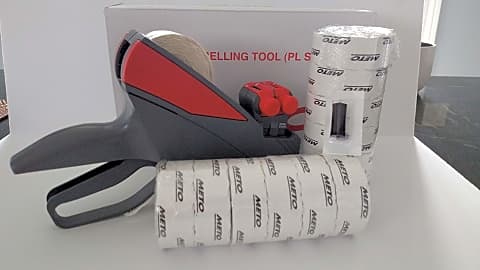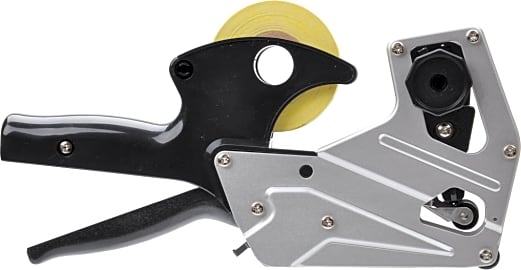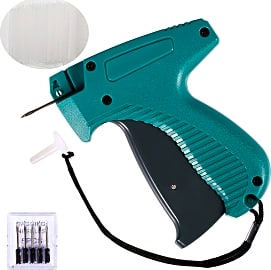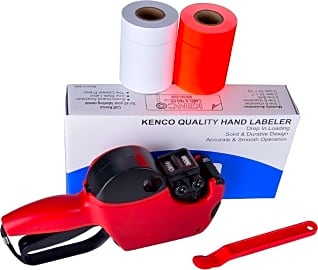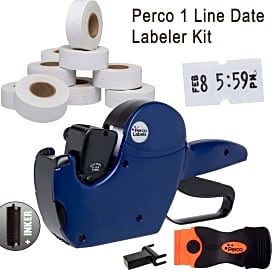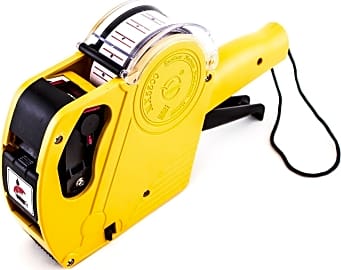The 9 Best Price Guns

This wiki has been updated 43 times since it was first published in August of 2015. If your business doesn’t have or need an electronic POS system that reads barcodes, you'll probably be familiar with these price guns. Some aren’t just for price tags, but are also good for adding expiration dates, on-sale percentages, and more, and will label anything you need significantly faster than hand marking. Models can vary in the number of character spaces and printing lines they offer. When users buy our independently chosen editorial recommendations, we may earn commissions to help fund the Wiki.
Editor's Notes
June 18, 2021:
We removed the XL Pro 25EEA because it's now remarkably difficult to get your hands on. Instead, we've added the BS One Tagging Gun, which is designed to fix price tags to soft items using a needle and thin plastic connectors that loop through cardboard tags. This one, of course, doesn't actually print any tags. For traditional printers, we still recommend the Monarch 1136, although the Garvey 1910 is notably less expensive and doesn't weigh as much.
January 21, 2020:
There are a couple of brands I like to see in any top price gun list, with the top two being Monarch and XL Pro. Both these brands make some of the best labelers around, and at least one model from each brand is worthy of a top-five spot. There are a lot of good options to choose from under both brands, but eventually, I decided to settle on the Monarch 1136 (which is a popular two-line model that complements the single-line Monarch Pricemarker 1131 already listed), and the XL Pro 25EEA. Of course, with both models, you can purchase value packs which include label rolls and ink rolls, but the options for these models looked very expensive, so I thought I'd leave it up to you to decide about add-ons.
Some other second-tier price gun manufacturers that are usually worth a mention or with at least one model are Meto, Garvey and to a lesser extent Towa - I believe that Towa makes all of their models from metal, so they're quite hardy and tough. Since the Towa GS275 and Garvey 1910 - two good options - were already listed prior to the update, I decided to include the Meto 15.22 Pack. Now, I could have added the Meto 15.22 standalone model, but I thought that the value pack was actually good value for money here.
I also wanted to include some two-line labelers, since all the models from before the update, with the exception of the Kenco Premium Kit, were single-line labelers. There are advantages to both types, with single-line labelers having a faster, smoother operation - dialing on the two-line models is a little bit fiddly and takes more time, but their advantage is obviously in the amount of character space you get with two lines and 15+ characters. All three new models I've included are two-line labelers. Three-line labelers also exist nowadays (I know that Monarch and Meto have three-line models), but I haven't included any since I personally don't think they're worth it - they're even more fiddly, and the labels are too big, and plus you can convey ample information in two lines.
Putting A Price On Convenience
And if you need to go the other way, towards affixing the label for life, you can try permanent labels.
A pricing gun is a device that lets you quickly and efficiently affix labels to items’ surfaces. Because these guns have an ink roller and stamps built-in, your labels can convey exactly the information you need, whether this is a price, date, unit of measurement, tracking number, store name, or something else, depending on the model. With today’s more sophisticated pricing guns, you can include more than one line of information, too, making them an efficient method of communicating data.
Pricing guns offer a variety of benefits to stores that do not have barcode scanners. To begin with, they eliminate the hassle of employees having to handwrite labels, then peel them off, then affix them, a process which can eat up valuable time. As a bonus, the printing on the labels from the pricing gun will be uniform, which means no messy or illegible writing. When the customer brings an item to the cash register, the transaction runs smoothly thanks to an easily identifiable price.
In fact, an easy-to-find price on an item helps make the entire shopping experience more agreeable for your customers. Many will not want to take the time to find someone and ask the price of an item, while others will be annoyed at the lack of crucial information. You might also add other useful info that customers ask for often, such as sell-by date or date of packaging. This will free up workers from having to answer the same questions all day long.
While pricing guns have many benefits, there’s one objection that people sometimes raise regarding their use: If you put stickers on boxes or products, people may eventually want to remove them — and if the stickers leave an unsightly or sticky mark, the customers probably won’t be happy. Fortunately, modern pricing guns accommodate various kinds of labels, including dissolvable and removable options. And if you need to go the other way, towards affixing the label for life, you can try permanent labels.
When To Use A Pricing Gun
Stores without electric point of sale systems are only one of the many places where a pricing gun can add value and save time. These tools give you highly customizable labels, making them excellent for a range of uses both in the office and at home.
A pricing gun prevents these kinds of headaches by letting you clearly mark each item.
For example, if you’re planning a rummage or garage sale, then a pricing gun can be a lifesaver. Sure, you could group all same-price items together and put them on tables with signs (e.g., “All items on this table cost X-amount”), but are you really going to remember which table every single item comes from on sale day? And do you trust people not to move items between tables? A pricing gun prevents these kinds of headaches by letting you clearly mark each item.
Another way to get use from a pricing gun is in food storage, whether in the home pantry or commercial food service. When the date of purchase or packaging and the expiration date are marked clearly on a food’s label, then the chance of using old, expired food goes down considerably. Adding a bright, permanent label can be helpful even when the expiration date is on the item, since this information is often hard to find or smudged.
Pricing guns can help with inventorying of non-food items, as well. Let’s say you run a jewelry business out of your home, which requires you to keep many small items in a variety of boxes. You can use your gun to quickly add info to these boxes, whether that’s pieces inside, date purchased, cost of each, item number, and so on. You can even purchase labels in a variety of colors to help you color-code your inventory.
Taking Care Of A Pricing Gun
A good pricing gun is an investment that can last you for years — if you take care of it properly. Much of caring for a pricing gun is common sense, but there are a few best practices that are worth highlighting.
Much of caring for a pricing gun is common sense, but there are a few best practices that are worth highlighting.
First, be gentle with it. Although a price gun is “analog” and doesn’t seem especially complex like a delicate piece of electronic machinery, it has plenty of moving parts that must fit together with precision. If you’re rough on it, you can jog these out of place or break them outright. To prevent accidental drops, use the wrist strap that most pricing guns include. Don’t end up with the frustration of being forced to replace the unit when the breakage could have been prevented by spending three seconds to put the lanyard around your wrist.
Second, use the right supplies with the pricing gun. As a general rule, manufacturers include information about the size and type of labels and ink pads that are compatible with the gun. They may even include model numbers for your convenience. By using the correct materials, you ensure that the gun operates the way it was designed to, which will prevent annoying problems. Make sure that your materials are in good condition, also, before you attempt to load them into the gun.
Third, if you do end up with an issue, such as a jam or broken piece, either take the time to stop and fix it or find someone who knows how to do so. For instance, if the labels are not coming out smoothly, the fix may be as simple as flipping open the body and cleaning it out. If you ignore the problem and try to keep working, however, you could end up with a much more difficult problem to solve.
Fourth, for the best results, work with a clean surface. Most labels won’t stick to dirty or wet materials. And if you plan to mark on a less-common material, such as rubber or concrete, look for labels designed specifically to stick to these.
Finally, when your ink pad runs out, don’t try to refill it. A replacement ink roller will cost you less than any damage you might do by trying to revive an old one.



